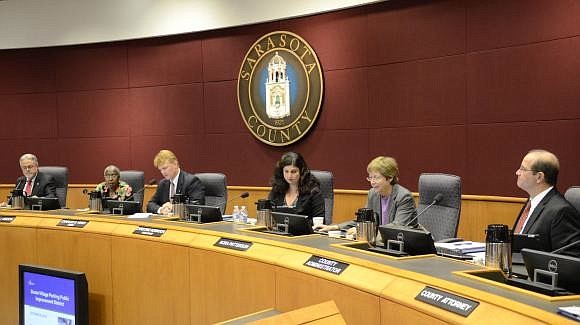- April 19, 2024
-
-
Loading

Loading

In the wake of protests from neighborhood and environmental groups this week, the Sarasota County Commission is set to finalize changes to the county's long-term building rules.
Commmissioners will hold a public hearing Wednesday, to consider adopting the proposed amendments to Sarasota 2050, which was enacted in the early 2000s to guide major developments in East County. The plan as-is allows developers to build more housing on smaller swaths of land in exchange for providing environmental protection and creating walkable, mixed-use communities, among other requirements.
The board sent the amendments to the state for review at its Aug. 27 meeting. The state reviewed the changes and did not identify any concerns, according to the staff memo.
The changes, which apply to unincorporated land east of I-75, have been a source of strife between those who support the amendments and those who do not since they were proposed in May.
On Monday, opponents of the amendments protested outside the county administration building, toting signs with declarations such as “sprawl hurts us all” and "is Florida a real state or just real estate?"
“This is a very narrow set of changes to benefit a handful of rural landowners,” said Cathy Antunes, vice president of Sarasota County Council of Neighborhood Associations, at the protest.
In 2012, the board requested input from developers about the plan. The developers cited several issues with 2050 that they deemed to make it almost impossible to implement.
One tenet of the plan, fiscal neutrality, was identified as making developing almost impossible. That concept is aimed at forcing a developer to prove that their proposed community would provide enoiugh tax revenue to offset costs associated with municipal infrastructure.
The proposed amendment makes the developer provide a long-term analysis at the beginning of the project and submit reports throughout the various phases of the development at a time the county decides. The amendment also provides an incentive for developers to build affordable housing by decreasing the amount of open space, often environmentally sensitive land, the developer has to purchase for every affordable unit.
Opponents of this change see the amendment as providing ways for developers to avoid proving fiscal neutrality and place the burden of the development on the tax payer.
Supporters of the amendments, however, say that the changes will allow developments to move forward unencumbered. Since the comprehensive plan’s adoption in July 2002, only three developments have been approved under 2050.
“The amendments are reasonable to bring fiscal neutrality into reality,” said local land-use attorney Bill Merrill, who has supported the changes.
Another concern for some community members is the elimination of the 15-year waiting period between village development approvals, and eliminating the policy with prevents the approval of a village if the additional units cause the dwelling unit capacity to exceed 150% of the forecasted housing demand over the following 20 years. Residents who live in the rural areas of east Sarasota County voiced concern that the elimination of these policies would drive a burst of overdevelopment.
“The rural area was traditionally agriculture and natural resources… it was adding to the community,” said Maynard Hiss, who spoke at the protest Monday. “The county commission isn’t planning for the county residents or the tourist industry… it’s just solely for developers to make a lot of money selling lots.”
IF YOU GO
What: Sarasota County Commission meeting
When: 9 a.m. Wednesday, Oct. 22
Where: Commission Chambers, Administration Building, 1660 Ringling Blvd., Sarasota